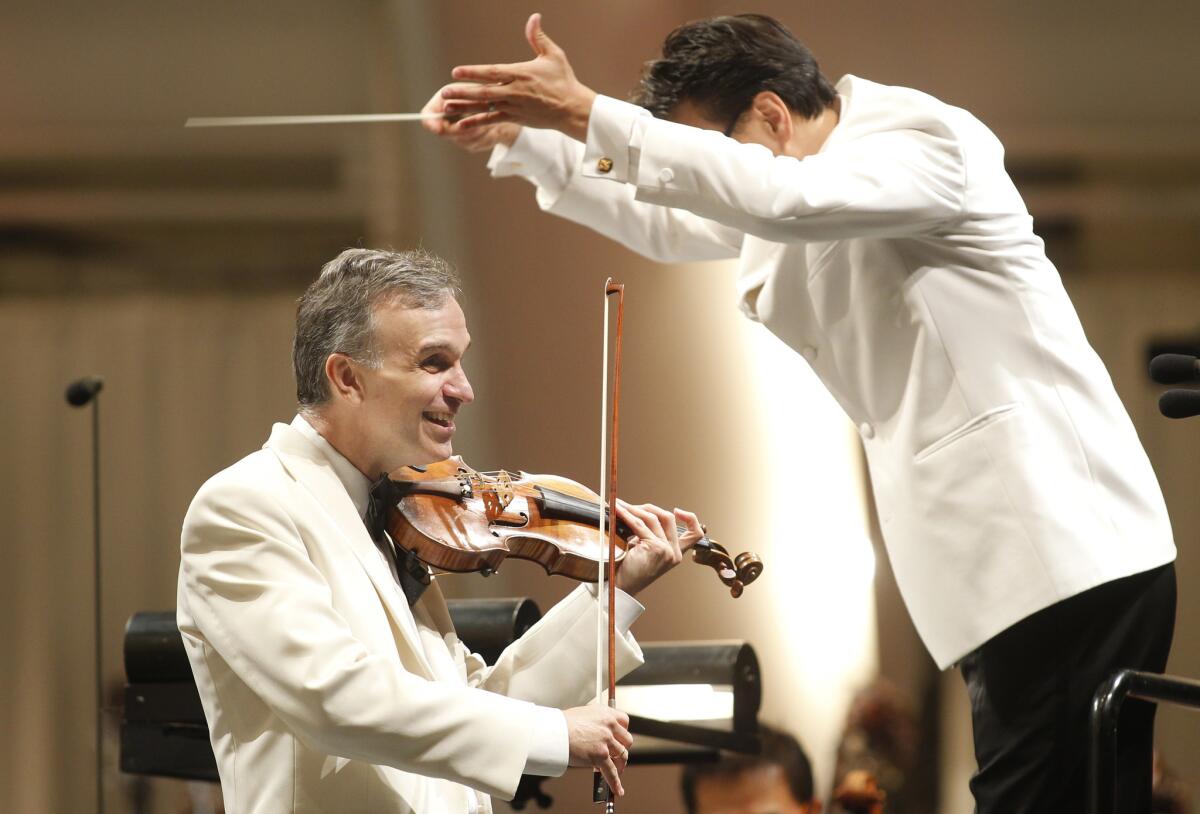Review: At the Hollywood Bowl, breathing life into the most famous symphony ever written

In his book âConducting Business,â Leonard Slatkin, former principal conductor of the Los Angeles Philharmonic at the Hollywood Bowl, recalls a time when bowl audiences cheered after the first four notes (ta-ta-ta-TA) of Beethovenâs Symphony No. 5 were played.
On Tuesday night, a large Bowl crowd held their cheers until conductor Ken-David Masur, making his Philharmonic debut, brought the first movement to a powerful close.
For the record:
1:52 p.m. Nov. 27, 2024An earlier version of this review contained a typographical error and used the word âbrassesâ instead of âbassesâ in describing how conductor Ken-David Masur highlighted cellos and basses.
Masur, the youngest son of conductor Kurt Masur, who was music director of the New York Philharmonic from 1991 to 2002, replaced an indisposed Joana Carneiro in a program also featuring Beethovenâs Overture to âFidelioâ and Erich Korngoldâs Violin Concerto, with Gil Shaham as soloist.
SIGN UP for the free Essential Arts & Culture newsletter Âť
Looking younger than his 39 years, Masur comes to the Bowl with impeccable credentials, including conducting studies with his authoritative father, who died in December at 88. A well-seasoned musician, Masur is the assistant conductor of the Boston Symphony and principal guest conductor of the Munich Symphony. Heâs held the post of associate conductor of the San Diego Symphony, and he also studied singing in Berlin with bass-baritone Thomas Quasthoff.
At the Bowl, the slender Masur proved a formidable technician, displaying a natural podium manner and persuasive musicianship. He gave a fleet, clear-textured account of Beethovenâs Fifth, steering the Phil through the calms and storms of the opening Allegro with authority.
Conducting without a baton, Masur used a score but hardly looked at it. He showed an impressive structural grasp both in his warm and perfectly paced Andante and in his supple shaping of the scoreâs wraith-like transition from the Scherzo into the bracing Allegro finale. Masur also highlighted the riveting virtuosity of the Philâs cellos and basses in the Scherzoâs trio section.
The concertâs curtain-raiser, Beethovenâs Overture to âFidelio,â was sensitively shaped by Masur, conveying the scoreâs hard-earned joy.
Korngoldâs Violin Concerto, like Beethovenâs Fifth, is another enduring audience favorite. Jascha Heifetz was also a fan â his recording with Alfred Wallenstein and the Phil is justly famous â and with good reason. The score offers soloists challenging passages for virtuosic display and, while richly melodic, itâs also pungent and skittishly inventive.
The Moravian-born Korngold repurposed several themes from his pioneering 1930s Hollywood film scores â âAnother Dawn,â âJuĂĄrez,â âAnthony Adverseâ and âThe Prince and the Pauperâ â for this dazzling 1945 concerto. Shahamâs playing captivated from the workâs quiet opening bars and never let up. Given the soloistâs concentrated, unsentimental account, especially in the sustained lyricism of the central Romanze, the applause after each of the three movements was well deserved.
Masur, skillfully turning the Phil into a Richard Strauss orchestra, conveyed Korngoldâs affinity for that composerâs opulent late-Romantic sound world. Perhaps as a nod to late-19th century maestros, the conductor used a baton for the Korngold.
Shaham likes to stand close to podium and conductor, somewhat inside the orchestra, creating a cohesive trio of collaborators. Magnified on the Bowlâs big hi-def screens, the violinistâs trademark grimaces belied how relaxed his body actually was, allowing him to produce a radiant tone. He was having a good time, and we were too.
Follow The Timesâ arts team @culturemonster.
More to Read
The biggest entertainment stories
Get our big stories about Hollywood, film, television, music, arts, culture and more right in your inbox as soon as they publish.
You may occasionally receive promotional content from the Los Angeles Times.










